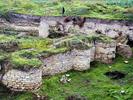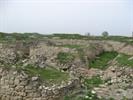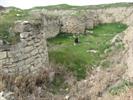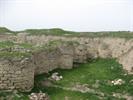The excavations at Shabran are not visually exciting. The few half-collapsed domes and the subterranean remnants of a small 16th-to 17th-century castle give little impression of the town's great historical significance. Still, the site is easy to visit while 'driving by' and worth a five-minute detour if you are heading for Nabran or Quba.
The ancient city of Shabran developed to exploit the then 'ideal climate of the narrow, fertile Caspian shore plain. Officially founded during the reign of Sassanid Shah Khosrov Anushirvan (531-579) it rapidh became one of the five main towns of Caucasian Albania and an important Caspian spur to the great Silk Routes.
Excavations indicate that it had advanced sewerage systems in the 9th century and piped fresh water from springs some 14km away. It later developed its own silk industry and, from the 9th to 12th centuries, was famous for 'Amilin Shabran glassware.
It was here that the great 12th-century poet Xagani was incarcerated and produced his famous 'prison poems Hebsiye. Though the site was sandwiched for safety between a system of protective walls, its relative vulnerability meant administratne power was moved to Shamakha whose hilltop position was easier to defend. Shabran was rebuilt after the Mongol destruction and it retained a trading role but when British wool merchants arrived in the 16th century they found Shabran's markets too small to bother with Raids by Khazar/Ossete gangs, Dagestani Lezghians and even (according to one source) Crimean Tatars, continued to undermine the city s reputation and eventually it withered away to nothing. Based on the archaeological and many writen sources Azerbaijan was a part of urbanistic civilization during the Middle Ages.One of the medieval sources notes that 'in Arran along Araz-river, there were ones thousand cities'.
Indeed, in the Middle Ages in Azerbaijan there were a lots of densely populated, well-biuilt cities with massive-structured fortifications, with monumental buildings, underground water pipe-line, sanitary-hygienic equipment, indoor markets, warehouses and developed commercial crafts. Culture, crafts, science in those cities were rapidly developing.
One of those towns was Shabran,(located in Divichi Region of Azerbaijan republic-211km north of Baku) which has emerged in V-VIIth century as the city-fortress, and by IX-Xth century had become a major political, administrative, trade, handicraft and cultural center. The city has experienced a rise and decline, flourishing and stagnation.
Shabran in X-XI centuries was an important political center of the Shirvanshakh state. It has been even suggested that it was the capital of the Shirvanshah state. Shirvanshakh family tomb built in the middle of the XIth century was actually located in Shabran. The city did not lose its power and influence till the first quarter of the eighteenth century. Travelers and scientists, diplomats and merchants admired its beauty. Turkish traveler Evliya Chelebi, who in 1647 was in Shabran was stunned by its brilliance, wrote: '... it is the second city in Persia after the Tabriz. It has 70 mihrabs and 70 quarters. Within the city lie famous mosques of Tokmak Khan, Afshar Khan, Uzun Hasan, whose beauty is not compared to anyother.
And even Ozdemir-oglu Osman Pasha every Friday came with a large retinue from Demirkapy into the Cathedral Mosque to perform his weekly namaz(prayer). The Cathedral Mosque is an ancient and dignified house of worship, the four walls of which are decorated by the thinnest smoothly shedding like chameleon skin ornaments, and its carved marble workmanship led to the astonishment of architectural art connoisseurs'.
But Shabran had a tragic fate. As a result of the disastrous events of the first quarter of XVIIIth century the city was badly damaged and burnt. Scorching southern sun, merciless winds, rains, desert sands turned the city in ruins soons to be abandoned. Already century later the local population did not even remember the name of "Shabran". They argued that the city, located near the village of Shahnazarli of the Divichi region was the ruins of the city Gyulistani-Irem. Only scientists and historian A.A Bakihanov first suggested and proved his theory that this location was the medieval city of Shabran. Archaeological excavations gradually returned the long lost history to the ruins. In I979-I989 on the territory of the city at five sites, archeological excavations were made as a result of which was uncovered area of more than 4500 square meters. The thickness of the cultural layer, that is another layer of residual material culture, was 5 meters, and reflected the highly developed culture belonging to IX-XVIIth centuries. A fortress dated to the Xth century was comopeletely excavated.. Scientists have determined that it was built for defensive purposes and its defense systems were noted for their reliability. The fortress walls were reinforced by semi0circled towers.
In the construction of the fortress were used a variety of materials - limestone, cobble-stone and reinforced brick. Shabran architects used different qualities of building materials to enhance outer walls. The outer part was built with testaceous stones, and the inner - made of river rocks and boulders. Entire wall was made with the help of highly concentrated lime mortar. Specifics of installation of the outer facing blocks - ('scooping' and 'wedging' in alternation) gave the wall remarkable strenght.
Incredibly the site was forgotten altogether during the 18 th century and only rediscovered by archaeologists in 1980. Thor Heyerdhal visited the site in 1983. Nobody has yet found the mythical Mekhak gold-divining stone.
If you're planning a trip to Azerbaijan you may be interested ▶ Azerbaijan highlights - For those who prefer to go unbeaten path, to explore less visited places and check national charisma of this small country in Southern Caucasus on the edge of Europe.










